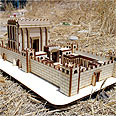
Expert: Menora may have been in West Bank
British archeologist tells Ynetnews: Every power that sought to imprison this icon eventually crumbled into dust
During a special interview with Ynetnews, Kingsley discusses his remarkable claim, and explains why he thinks the artifacts are best left alone in their native soil.
"The precise route of the Temple treasure's main symbolic objects can be accurately traced down until AD 614-617, when chaos descended on Jerusalem as the Sasanian forces of Persia swept down on Palestine like a plague of locust," Kingsley explains. "At that time the spoils looted from the Temple in AD 70 were being stored in the Church of the Holy Sepulchre. Their fate after that is a matter of educated detective work through deteriorating 'historical DNA'. The most logical explanation we have places the treasures in the Monastery of St Theodosius (near Bethlehem – Y.L.), the ecclesiastical base of the new Patriarch of Jerusalem, Modestus."
"In the Monastery of St Theodosius the treasures of Jerusalem's Temple would have been spared Persian fire and chaos," Kingsley says.
Are there others who have reached the same conclusion, and who also share this secret? Quite possible, says Kingsley. "It would be unscientific of me to say objectively. Without doubt, the pattern of soil disturbance in the grounds of the Monastery of St Theodosius shows that illegal metal detectorists have been busy and disturbed underground chambers. There is a very high chance that whatever languished between the shifting sands of the West bank has been looted. Did this include the Temple treasure? I can only hope not," he says.
'Best left locked away'
Despite the prospect that the Temple artifacts could be so close to home, Kingsley warns of the dangers of attempting to retrieve them. " So many dangerous dreams for messianic redemption hinge on this Jewish birthright that I believe it would remain far safer for humanity locked away in the cleansing soils of the Holy Land, dreamt over but not recovered," Kingsley says.
He adds: "The Temple Mount is the centre of world religion but also a seething volcano of human hatred in the Arab-Israeli conflict. It takes very little provocation for all hell to break loose in Jerusalem. The Temple treasure should today be a global treasure that unites people, not a political tool validating the construction of a Third Temple on the Haram al-Sharif. If the menorah's Diaspora over the centuries tells us anything then it is a wise lesson about the irrationality of religious fanaticism: every power that sought to imprison this icon eventually crumbled into dust."
Where is the Menora?
Kingsley says that the fate of the Temple Menora, the official symbol of the State of Israel, is likely tied to the other artifacts pillaged by Rome: "Most of the splendours of the Temple were eagerly liquidated into cash by the emperor Vespasian who needed 4,000 million sesterces (£2.25 billion) to get the (Roman) empire back on an even keel after civil war, anarchy and the great fire of Rome of AD 64 left the Eternal City looking worn out. The menora, silver trumpets and Table of the Divine Presence were acknowledged as key symbols of power. Control these and you controlled heaven, the seas and all between. Rome knew that the menora was a hotline to God and was keen to 'imprison' this divine power for its own benefit. The same held true for subsequent possessors – Vandals and Byzantines."
Kingsley is confident that the Menora is not, however in the Vatican vaults, as is widely suspected by many. "I have absolutely no political or theological axe to grind but my new research proves beyond doubt that the menora was never in Rome in the medieval period or later but by the seventh century AD was only a few miles away from Jerusalem in the West Bank."
Temple Mount responsibility
Addressing the controversial treatment by the Waqf Islamic trust of Jewish artifacts on the Temple Mount, Kingsley said there was room for concern. "This is a complex and tortuous issue. To any clear-minded archaeologist who has visited the Haram al-Sharif complex (Temple Mount) in the last few years, there is 100% no shadow of a doubt that ancient levels have been heavily disturbed without being recorded or studied. This includes architecture and small finds. No ancient pottery has ever been published from the holiest place on earth, but from what I saw during my visits, with an afternoon's formal research of these holy deposits I could have prepared a scientific article on the history of the Temple Mount in all ages," he says.
"Technically, because Moshe Dayan gave the keys back to Jordan in 1967 the emphasis is on the Waqf to respect international law. In this case, where the Temple Mount is being used as a deadly political pawn, UNESCO ought to be central to resolving the problem. But again, this is a heavily political organization that is proving completely ineffective and letting humanity down by trying to keep its nose clean. UNESCO is supposed to work for the good of universal culture and ought to be concerned by its weak leadership. If we should blame anyone, I'm afraid it should be UNESCO."
Sean Kingsley's book God's Gold The Quest for the Lost Temple Treasure of Jerusalem , will be published on October 5. More information can also be found at www.godsgold.org










